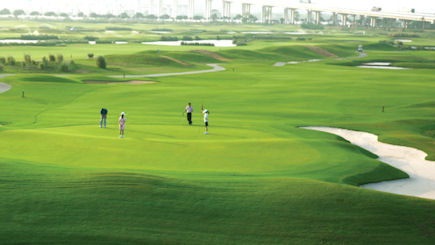This article first appeared in the May/Jun 2015 issue of WGM.
WGM is proud to welcome PGA Teaching Professional at Caesars Golf Macau, Chris Connell, to the team. Chris’ valuable golfing tips and insights will help improve your game. But before we get started, we thought we would find out a bit more about him and how he wound up teaching golf here in Macau!

WGM: Hi Chris, it’s our privilege to have you on board to provide our readers with some interesting and insightful golfing tips. Can you tell us a bit about your golfing background?
Chris Connell: Actually football was my big passion from an early age and I did quite well until I was about 12 and realized I probably was not going to be good enough to play professionally. My father was a keen golfer and I had played a little bit but nothing serious. From 13 onwards I got into the game and just before my 17th birthday I turned professional.
WGM: How far did your professional career take you and when did coaching start to become a focus for you?
CC: I did all my PGA qualifications and also played a pretty full playing schedule until I was around 23 when I became more involved in coaching. I realized I wasn’t good enough to play for a living but I had an understanding of coaching and it grew from there. I had several “Head Professional” roles in the UK but I was really only cut out for coaching as my diary was always full and I had little time to devote to other areas of a Head Professional life. So in my early 30s I became a full time coach.
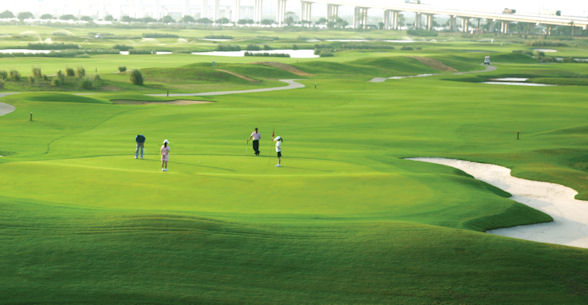
WGM: You cut your teeth as a coach with Butch Harmon, who is widely renowned as the world’s best golf instructor and has coached the likes of Tiger Woods, Phil Mickelson and Ernie Els. How beneficial was that to you?
CC: Mr Harmon’s schools are very limited now. The school in Macau has closed and there are only three left – two in the US and one in Dubai. Mr Harmon has a small number of professionals working at his schools who have been with him for many years and they have all been lucky enough as I have to shadow the great man and watch how he goes about his work. As Mr Harmon and all his professionals don’t believe in a swing system, it’s down to working with the individual in front of you to get the best you can out of them. I spent three weeks at the school in Las Vegas where I worked with Mr Harmon and his team which was my validation into his team.
WGM: What would you say is the biggest mistake made by casual or “weekend” golfers in your experience?
CC: General setup issues. It often shocks me when I play on the course to see how far offline golfers can be when trying to go to a specific target. Of course, if the alignment is out everything is out which ruins the geometry of the swing and we have issues.
WGM: How did you end up working at Caesars Golf in Macau?
CC: I came to Caesars in February 2011 after a successful interview with Mr Harmon in December 2010. I had been working on the PGA European Tour coaching at tournaments when a pro friend of mine gave me a contact for the job here at Caesars working for Mr Harmon at his school in Macau.
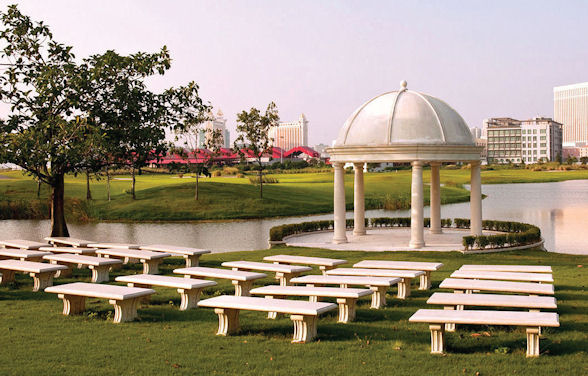
WGM: For those yet to enjoy a round at Caesars, what can you tell us about the course and also what’s on offer at Caesars as a whole?
CC: First of all, the course at Caesars is always in excellent condition with particularly fine greens all year round. It is based on a links type layout with mounding, waste areas and plenty of water. The course layout is well thought out with challenging black tees and more comfortable white tees, so it’s a good challenge for all standards. It has some tough Par 3s with water in play and some long challenging Par 5s. I think the perception of people who have never been here and see it from the road is that it is flat and there isn’t much to it but it is a good course and tough when the wind blows, as all links courses are. We also have an excellent range and short game area and one of the finest Golf Schools in Asia designed to Butch Harmon’s specifications.
WGM: Run us through a typical work day in the life of Chris Connell?
CC: My working day starts around 09:00. I will get to the school based on the range, check the range first and chat to my students who are regulars, then get the school ready for the day. Depending on the time of year I could have up to six or seven hours of lessons daily. I normally have an hour lunch break with my wife then finish coaching around 18:00 or 19:00. Upon leaving for home I will do a last trip down the range to check the progress of any of my students and give them some words of encouragement if needed.
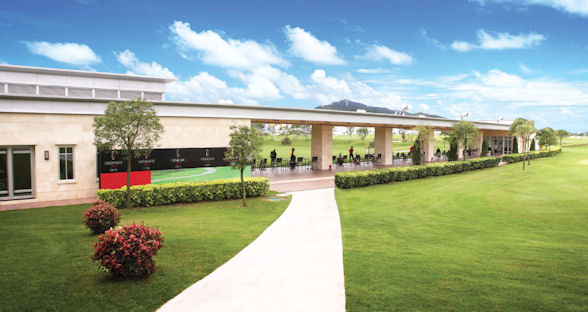
WGM: Finally, what do you love most about your job?
CC: The things I love about the job are numerous – taking someone from never holding a club to playing on the course and watching them improve; watching someone struggling with their game make a slight adjustment and suddenly finding it all works; working with Tour players (I have several throughout the world I work with); and working with and developing talented juniors. I have several world class kids from Asia as students right now and they have already won big tournaments in the US. And of course working in a great environment and getting paid for it.
Chris Connell presents his first golfing lesson!
GET YOUR FUNDAMENTALS RIGHT
Here at The Caesars School of Golf we do not teach a system or method, we simply work with our students to get the most out of their individual golf game. But one of the things we do want every golfer at the school to have is a set of principles to follow regarding the fundamentals of the game.
The swinging motion of the club and the movement of the body are directly affected by the fundamentals at the address position and almost all swing faults will be traced back to an individual’s address position.
The way you hold the club, the way in which you position your body in relation to the ball and the way in which you aim the club face will all determine the outcome of every shot you hit.
GRIP
A good grip is one which enables you to point your club face in the direction you are swinging it at impact, while swinging at speed. The club should be held primarily in the fingers with the hands relaxed but firm to keep complete control of the club face. Grip pressure should be somewhere between 4 and 6 on a scale of 1 to10, with 10 being the firmest. To apply a neutral grip, the V between the thumb and forefinger of both hands should be pointing between the chin and right shoulder.

A strong grip can be related to closing the club face on impact with the ball. This will cause a de-lofting of the club face resulting in a lower flight with misses to the left of the target.
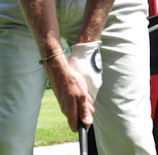
A neutral grip will give you the best possible chance at impact of having a square club face. This will allow correct ball flight for all clubs and neutral spin, keeping shots more on the target line.
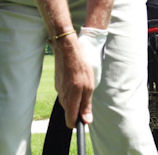
A weak grip will have the effect of opening the club face on impact with the ball. This will cause an increase in loft resulting in a higher ball flight with misses to the right of the target.
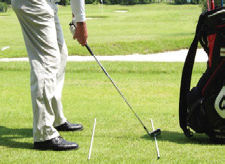
ALIGNMENT
Club face square to the target line behind the ball with your stance and body alignment (feet, hips, forearms, shoulders) parallel to the ball/target line just like a railway line.

BALL POSITION
Maintain a consistent ball position in line with your left breast or logo of your shirt on level lies.

POSTURE
This refers to the overall position of the body at address. Feet should be shoulder width apart for a standard shot with weight more on the balls of the feet to about 80 percent. The body should be in an athletic ready position, knees flexed, a slight tilt forward from the hips, back straight with arms hanging vertically and the chin up clear of the chest.
When you are next at the range or on the course, pay more attention to your fundamentals because they will allow you to swing with more consistency. Always remember that the spin factors of the ball through the air show up the weakness in your technique which I guarantee will be related to one or several areas of your fundamental address position.

